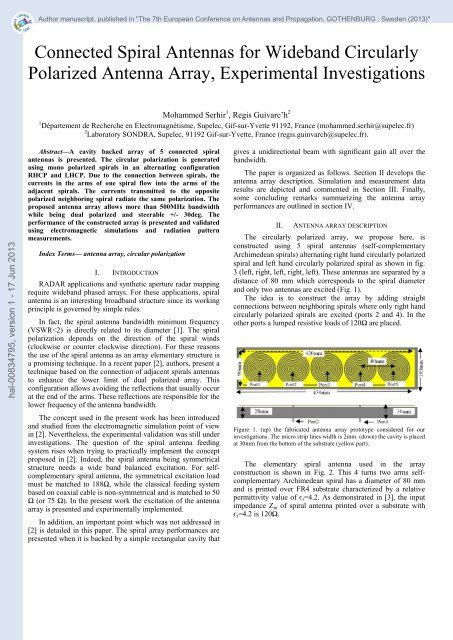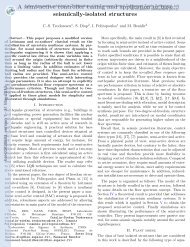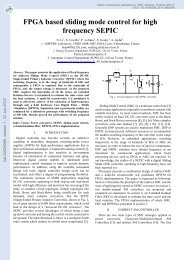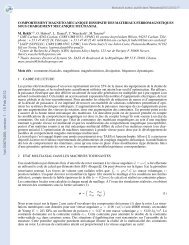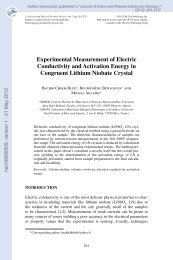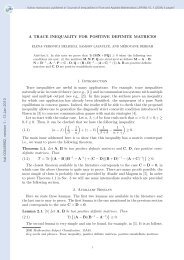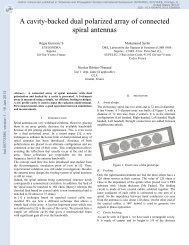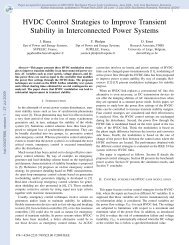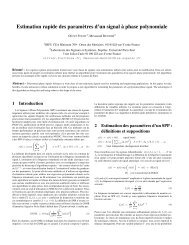Connected Spiral Antennas for Wideband Circularly Polarized ...
Connected Spiral Antennas for Wideband Circularly Polarized ...
Connected Spiral Antennas for Wideband Circularly Polarized ...
You also want an ePaper? Increase the reach of your titles
YUMPU automatically turns print PDFs into web optimized ePapers that Google loves.
Author manuscript, published in "The 7th European Conference on <strong>Antennas</strong> and Propagation, GOTHENBURG : Sweden (2013)"<br />
<strong>Connected</strong> <strong>Spiral</strong> <strong>Antennas</strong> <strong>for</strong> <strong>Wideband</strong> <strong>Circularly</strong><br />
<strong>Polarized</strong> Antenna Array, Experimental Investigations<br />
Mohammed Serhir 1 , Regis Guivarc’h 2<br />
1 Département de Recherche en Électromagnétisme, Supelec, Gif-sur-Yvette 91192, France (mohammed.serhir@supelec.fr)<br />
2 Laboratory SONDRA, Supelec, 91192 Gif-sur-Yvette, France (regis.guinvarch@supelec.fr).<br />
hal-00834795, version 1 - 17 Jun 2013<br />
Abstract—A cavity backed array of 5 connected spiral<br />
antennas is presented. The circular polarization is generated<br />
using mono polarized spirals in an alternating configuration<br />
RHCP and LHCP. Due to the connection between spirals, the<br />
currents in the arms of one spiral flow into the arms of the<br />
adjacent spirals. The currents transmitted to the opposite<br />
polarized neighboring spiral radiate the same polarization. The<br />
proposed antenna array allows more than 500MHz bandwidth<br />
while being dual polarized and steerable +/- 30deg. The<br />
per<strong>for</strong>mance of the constructed array is presented and validated<br />
using electromagnetic simulations and radiation pattern<br />
measurements.<br />
Index Terms— antenna array, circular polarization<br />
I. INTRODUCTION<br />
RADAR applications and synthetic aperture radar mapping<br />
require wideband phased arrays. For these applications, spiral<br />
antenna is an interesting broadband structure since its working<br />
principle is governed by simple rules.<br />
In fact, the spiral antenna bandwidth minimum frequency<br />
(VSWR
hal-00834795, version 1 - 17 Jun 2013<br />
Figure 2. The elementary spiral antenna (left) and its feeding system (right)<br />
Figure 3. Calculated reflection coefficient of the elementary spiral<br />
The elementary spiral antenna feeding system is made of<br />
two RG-10 coaxial cables soldered together where the inner<br />
conductor of each cable is connected to the spiral arms. Doing<br />
this, the impedance between inner conductors (seen by the<br />
antenna) is also about 100Ω. On the other coaxial cables end a<br />
180° hybrid coupler is used to generate two opposed-phase<br />
signals. This versatile excitation technique can be generalized<br />
to any symmetrical structure <strong>for</strong> which the input impedance is<br />
around 100Ω. Using the electromagnetic simulation software<br />
CST Microwave Studio [4] we calculate the spiral antenna<br />
reflection coefficient as a function of the frequency when it is<br />
excited by the feeding system described above.<br />
As it can be seen from Fig. 3, the antenna S11
and simulated far-field radiation pattern resulting from the<br />
prototype presented in Fig. 7. As it can be seen a good<br />
behavior agreement is noticed. Based on measurement data,<br />
the spiral array has a 650MHz bandwidth from 0.85GHz to<br />
1.5GHz. This bandwidth is confirmed by a good S11 (below-<br />
10dB).<br />
in Fig. 9, the use of the lumped resistive loads does not affect<br />
drastically the radiation pattern.<br />
without resistive loads<br />
Figure 5. Measured S11 coefficients as a function of the frequency<br />
hal-00834795, version 1 - 17 Jun 2013<br />
Figure 6. Comparison of the simulation and measurement Axial Ratio as a<br />
function of the frequency in the broadside direction (θ=0°).<br />
resistive loads<br />
Figure 7. The antenna array with lumped resistive loads.<br />
with resistive loads<br />
without resistive loads<br />
Figure 8. Axial Ratio issued from simulation and measurement data as a<br />
function of the frequency in θ=0° direction <strong>for</strong> spirals with resistive loads.<br />
In Fig. 9, the measured electric field over a hemisphere (-<br />
90°≤θ≤90° and 0≤φ≤180) is presented <strong>for</strong> frequencies inside<br />
the antenna array bandwidth ([0.85GHz 1.35GHz]). As shown,<br />
with resistive loads<br />
Figure 9. Radiation pattern of the spiral array in two different frequencies<br />
0.86GHz and 1.34GHz.
IV.<br />
CONCLUSION<br />
A versatile and efficient cavity backed circularly polarized<br />
array of spiral antenna has been presented. This spiral antenna<br />
array guarantees 500MHz bandwidth where the VSWR is less<br />
than 2 and the axial ration less than 3dB. In this paper we have<br />
excited port2 and port4 to reach the right hand circularly<br />
polarized array (RH). To achieve the left hand circular<br />
polarization (LH) port 1, port 3 and port 5 have to be excited.<br />
Consequently this antenna array structure allows us to realize<br />
LHCP and RHCP polarization. The minimum frequency of the<br />
array is less than the minimum frequency of a single spiral<br />
antenna composing the array structure.<br />
REFERENCES<br />
[1] R. G. Corzine and J. A. Mosko, Four-Arm <strong>Spiral</strong> <strong>Antennas</strong>. Boston,<br />
MA: Artech House, 1990.<br />
[2] R. Guinvarc'h and R.L. Haupt, “Connecting spirals <strong>for</strong> wideband dual<br />
polarization phased array,” <strong>Antennas</strong> and Propagation, IEEE<br />
Transactions on, vol.59, no.12, pp.4534-4541, Dec. 2011<br />
[3] M. McFadden, W. R. Scott Jr.,” Analysis of the Equiangular <strong>Spiral</strong><br />
Antenna on a Dielectric Substrate” <strong>Antennas</strong> and Propagation, IEEE<br />
Transactions on, vol.55, no.11, pp.3163-3171, Nov. 2007<br />
[4] CST Microwave Studio, Tutorial<br />
hal-00834795, version 1 - 17 Jun 2013


